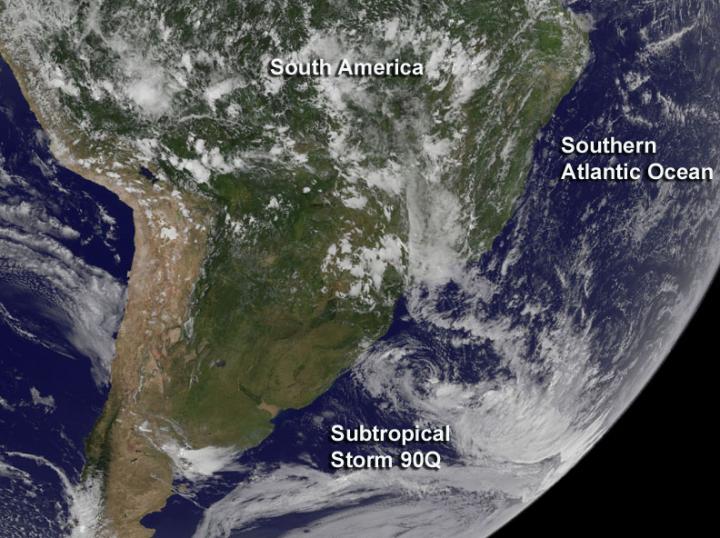Satellite sees rare subtropical storm 90Q in southern Atlantic

This GOES-East "full disk" view of the Atlantic Ocean from 17:45 UTC (1:45 p.m. EDT) on March 12 shows newborn sub-tropical cyclone 90Q. Credit: NASA/NOAA GOES Project
NOAA's GOES-East satellite provided imagery of the Atlantic that showed Subtropical Cyclone 90Q off the southeastern coast of Brazil at 17:45 UTC (1:45 p.m. EDT).
The system appeared to have fragmented banding of thunderstorms around the low-level center.
The image was created by NASA/NOAA's GOES Project at NASA's Goddard Space Flight Center in Greenbelt, Maryland.
At 1200 UTC (8 a.m. EDT) on March 12, the Brazilian Navy Hydrographic Centre (BNHC) noted that Sub-tropical storm 90Q was located near 32 degrees south latitude and 44 west longitude.
90Q's minimum central pressure was estimated near 1006 millibars. Maximum sustained winds were near 45 knots (51.7 mph/83.3 kph) and it was moving to the south-southeast at 5 knots (5.7 mph/9.2 kph).
For more information, visit the BNHC website at: http://www.
Media Contact
All latest news from the category: Earth Sciences
Earth Sciences (also referred to as Geosciences), which deals with basic issues surrounding our planet, plays a vital role in the area of energy and raw materials supply.
Earth Sciences comprises subjects such as geology, geography, geological informatics, paleontology, mineralogy, petrography, crystallography, geophysics, geodesy, glaciology, cartography, photogrammetry, meteorology and seismology, early-warning systems, earthquake research and polar research.
Newest articles

Red light therapy for repairing spinal cord injury passes milestone
Patients with spinal cord injury (SCI) could benefit from a future treatment to repair nerve connections using red and near-infrared light. The method, invented by scientists at the University of…

Insect research is revolutionized by technology
New technologies can revolutionise insect research and environmental monitoring. By using DNA, images, sounds and flight patterns analysed by AI, it’s possible to gain new insights into the world of…

X-ray satellite XMM-newton sees ‘space clover’ in a new light
Astronomers have discovered enormous circular radio features of unknown origin around some galaxies. Now, new observations of one dubbed the Cloverleaf suggest it was created by clashing groups of galaxies….





















